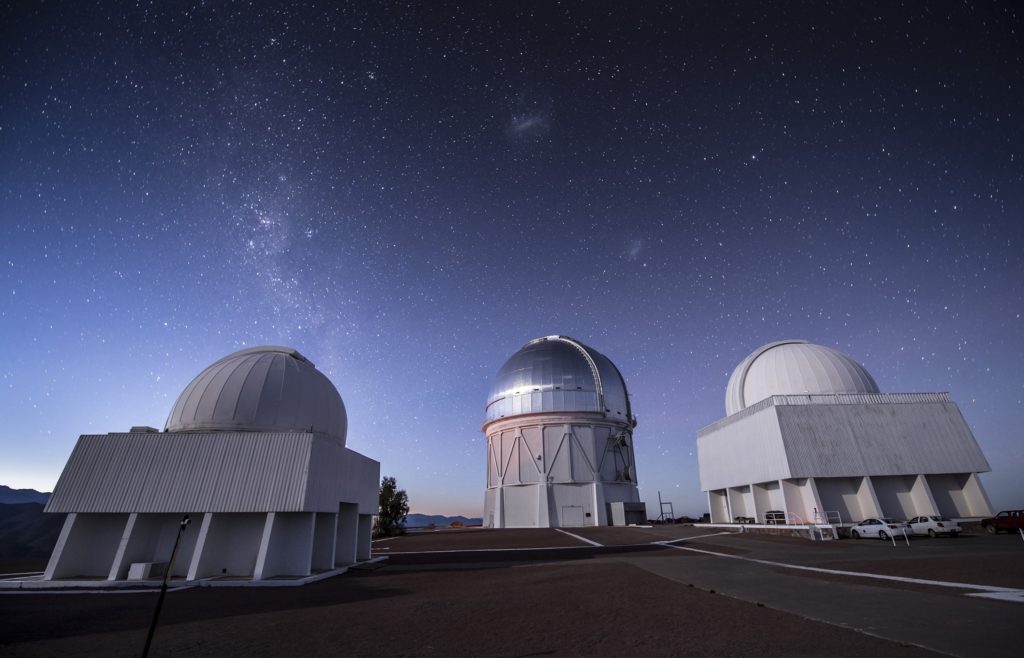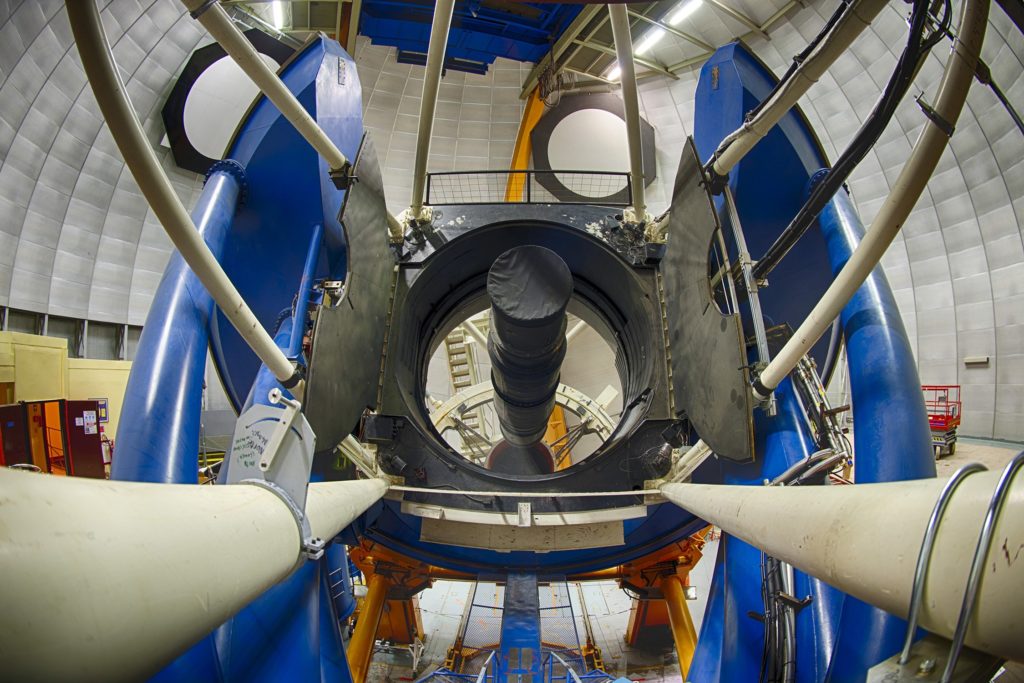
Highlights
- Data collected in the Dark Energy Survey (DES) covered one eighth of the sky
- The calibration system that allows scientists to capture the images was built within Texas A&M’s Munnerlyn Astronomical Laboratory
- The thousands of exposures taken will help scientists gain a better understanding of the Milky Way Galaxy and other distant galaxies
Texas A&M University astronomers are among hundreds of Dark Energy Survey (DES) scientists globally celebrating the public release of the survey’s first three years of data.
The first major release of DES data, announced Wednesday (Jan. 10) at a special session held during the American Astronomical Society 231st Meeting in Washington, D.C., features information on about 400 million astronomical objects, including distant galaxies billions of light years away as well as stars in our own Milky Way Galaxy.
The public release of the first three years of DES data fulfills a commitment made by survey scientists to share their findings with the astronomy community and the public. The data, which are accessible online, cover the full DES footprint — about 5,000 square degrees, or one eighth of the entire sky — and include roughly 40,000 exposures taken with the Dark Energy Camera (DECam), the 570-megapixel imaging device and primary instrument for DES for which Texas A&M astronomer Darren DePoy served as the project scientist. The images, which correspond to hundreds of terabytes of data processed at the National Center for Supercomputing Applications at the University of Illinois at Urbana-Champaign, and are being released along with catalogs of hundreds of millions of galaxies and stars.
DECam was built and tested at the U.S. Department of Energy’s Fermi National Accelerator Laboratory, the lead laboratory on the Dark Energy Survey. DePoy led the team that commissioned the enormous device, which is mounted on the National Science Foundation’s 4 meter Blanco telescope, part of the Cerro Tololo Inter-American Observatory in Chile, a division of the National Optical Astronomy Observatory. In addition, a key sub-component of the camera — a spectrophotometric calibration system known as DECal that enables the camera to obtain very high precision brightness measurements of the objects it sees in the sky — was built within Texas A&M’s Charles R. ’62 and Judith G. Munnerlyn Astronomical Laboratory under the direction of DePoy and fellow Texas A&M astronomer Jennifer Marshall.
Understanding the Milky Way Galaxy
Andrew Pace, a Mitchell Postdoctoral Fellow in Astronomy within Texas A&M’s George P. and Cynthia Woods Mitchell Institute for Fundamental Physics and Astronomy, was part of the DES team that vetted the data included in today’s release. In addition, Texas A&M astronomy graduate student Peter Ferguson* conducted a significant part of the analysis in the DES paper announcing one of the new discoveries enabled by the data set — the detection of 11 new streams of stars around our Milky Way.
“The DES vetting team examined the entire DES footprint to ensure that the data would be useful for the entire astronomical community,” Pace said. “Useful in this case is making sure there is nothing obviously wrong with the data. In converting DECam’s raw data into astronomical catalogs indicating positions and brightness of objects in the sky, we wanted to be sure that everything went as smoothly as possible. Rather than individual objects, we look for any unexpected trends and do cross-checks on subsets where we know what we should get back and also using external catalogs from other surveys.”

For his part, Ferguson describes stellar streams as objects such as globular clusters or dwarf galaxies that have been ripped apart by the Milky Way and smeared across the sky. They can offer important information about the Milky Way’s formation history, sometimes coined as Galactic archaeology. However, because they are composed of relatively few stars spread out over a large area of sky, these stellar streams are extremely difficult to find, even for an instrument as powerful as DECam.
“They contain information about the current state of the Milky Way and can be used to characterize its gravitational field and estimate its mass,” Ferguson said. “Additionally, small disturbances in streams can be used to explore Milky Way substructure, which includes constraining different dark matter models.”
Beyond helping with analysis of the locations and orientations of the streams, Ferguson used orbit models to look for any previously known streams that could be associated with the newly discovered DES streams. He also searched for any nearby globular clusters or dwarf galaxies that could have acted as progenitors for the streams.
“I think this paper contains some really exciting results and opens the door for a lot more work on this topic, helping us to understand our place in the Milky Way Galaxy and how it evolved to the state we see it in today,” Ferguson added.
An international collaboration
Prior to the new discoveries by DES, only about two dozen stellar streams had been discovered. Many of them were found by the Sloan Digital Sky Survey, a precursor to the Dark Energy Survey. Since there is no universally accepted naming convention for stellar streams, the Dark Energy Survey has reached out to schools in Chile and Australia, where students and their teachers have worked together to name the streams after aquatic words in native languages from northern Chile and aboriginal Australia. Read more about the names in this story from Symmetry magazine.
Pace says he got involved in DES data-vetting as a representative of the Milky Way (MW) working group, in which he works with Marshall and Texas A&M astronomer Louis Strigari to discover and follow up on new MW satellites. He admits that makes him a little biased toward MW science when it comes to identifying DES high points thus far. Beyond the field-of-streams paper involving Ferguson, Pace says his top three in no particular order consist of the first year of cosmology results (“the science here is the primary mission of the DES and came out better than expected and will only get better with more data”), the discovery of the optical counterpart to the neutron star merger (“first discovered via gravitational waves”) and the search for MW satellites papers (“so far, there have been around 23 objects found within the survey, which is higher than I expected.”)
Texas A&M Astronomer Jennifer Marshall Witnesses Cosmic History In Chile
Papers drawn from the first years of DES data can be found online, along with an animation of several of the newly discovered streams.
DES plans one more major public data release after the completion of the survey’s five-year mission, which runs through 2018. This future release will include nearly twice as many exposures as featured in the current release.
In addition to DePoy, Marshall and Strigari, fellow Texas A&M astronomers and Mitchell Institute members Lucas Macri, Casey Papovich and Nicholas Suntzeff are full members of the 400-plus-member international DES collaboration that spans 26 institutions and seven countries as well as the gamut of science and engineering in the search for answers regarding the universe’s accelerated expansion. Texas A&M statistician James Long and Mitchell Institute Postdoctoral Fellow Peter Brown also are external collaborators.
Read more on the announcement – including quotes from affiliated scientists, administrators and funding entities – via the official Fermilab press release.
# # #
Media contact: Shana K. Hutchins, (979) 862-1237 or shutchins@science.tamu.edu, Andrew Pace, (979) 845-7778 or apace@tamu.edu or Peter Ferguson, (979) 845-7778 or petersferguson@physics.tamu.edu





